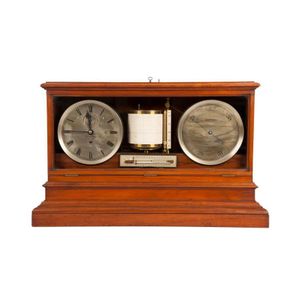Victorian Barograph and Clock with Aneroid Barometer
You must be a subscriber, and be logged in to view price and dealer details.
Subscribe Now to view actual auction price for this item
When you subscribe, you have the option of setting the currency in which to display prices to $Au, $US, $NZ or Stg.
- Victorian Period - The Victorian period of furniture and decorative arts design covers the reign of Queen Victoria from 1837 to 1901. There was not one dominant style of furniture in the Victorian period. Designers used and modified many historical styles such as Gothic, Tudor, Elizabethan, English Rococo, Neoclassical and others, although use of some styles, such as English Rococo and Gothic tended to dominate the furniture manufacture of the period.
The Victorian period was preceded by the Regency and William IV periods, and followed by the Edwardian period, named for Edward VII (1841 ? 1910) who was King of the United Kingdom and the British Dominions and Emperor of India for the brief period from 1901 until his death in 1910. - Frank Hyams Ltd. - Frank Hyams purchased a jewellery business in Princess Street Dunedin in 1885. As well as a manufacturing jeweller, he was a silversmith and goldsmith and specialised in jewellery incorporating New Zealand greenstone. At the New Zealand and South Seas Exhibition in 1890 he secured "first order of merit" for the manufacture of gold, gem and greenstone jewellery.
Concurrent with his Dunedin store, in 1902 Frank Hyams registered a limited company, Frank Hyams Ltd., and established a business in London, at 167 New Bond Street, and later at 128 New Bond Street, London, trading as 'artistic jewellers, gold and silversmiths, and dealers in gems of rarity'.
Frank Hyams established a reputation within the English aristocratic and upper class social circles for his unique one-off curiosity pieces incorporating materials and design influences from his New Zealand homeland.
The British Museum has a collection of 36 badges manufactured by Frank Hyams Ltd., circa 1906.
According to the London Gazette, in 1913 at an Extraordinary General Meeting it was voted that the company be voluntarily wound up and Frank Hyams was appointed liquidator.
This item has been included into following indexes:
Visually similar items

An Edwardian mahogany bracket clock with 'Buren' Swiss mechanical movement. Height 15.3 cm

Mappin & Webb (London) oak cased bedroom clock, with French movement, 18.5 cm wide, 19.5 cm high, working when tested

Edwardian oak mantle clock with handle, height 34 cm. Provenance: Orlando Brown Collection, Mosman

Clock by W. Simpson in floor standing walnut case with George Graham deadbeat escapement. Complexities include seconds sweep hand, day, date, month & strike on the hour. Also plays tunes on three adjustable tone gongs. Mechanical/electrical with three weig
